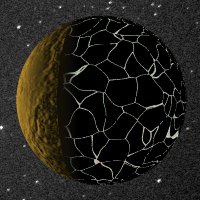
Inverness is tide-locked, but unlike most tide-locked worlds the night side is the inhabitable side. The day side roasts under a scorchingly close sun, while the heat that circulates through the atmosphere keeps much of the night side at livable temperatures for humans. A small ice cap covers the centre of the night side, but most of the rest is inhabitable, except for sauna-like regions near the terminator. With temperatures above boiling point, the day side is instant death for anyone not wearing sealed protective gear.
Imported Earth plants have been genetically adapted to the constant darkness of the temperate zone. They now use ambient heat to synthesise sugars necessary for growth, but this is a much slower process. Some animal species have been successfully imported and released into the wild - mostly nocturnal species, but also some genetically modified types.
The heavy gravity means Inverness is a leader in high-G medical research and also manufacture of heavy G machinery such as exoskeletons.
Despite hundreds of years of research and development work, Inverness is unable to grow enough fresh food. Much of the population's food is produced artificially in vats, but there is a large market for imported fresh food. The world also imports significant quantities of other organic materials, including plastics, medical drugs and luxury products.
Society is fairly free, but criticism of the Church or the monarch is not allowed, and such opinions are repressed. Members of other religions are free to worship as they choose within the civil laws of the planet, but only citizens in good standing with the Church of Inverness receive social security benefits and subsidised education and health care.
On interplanetary councils, the monarch, the archbishop, and the prime minister appoint one representative each. Since the monarch is a staunch Church member, and the PM often is, this usually means the Church decides interplanetary policy unilaterally.